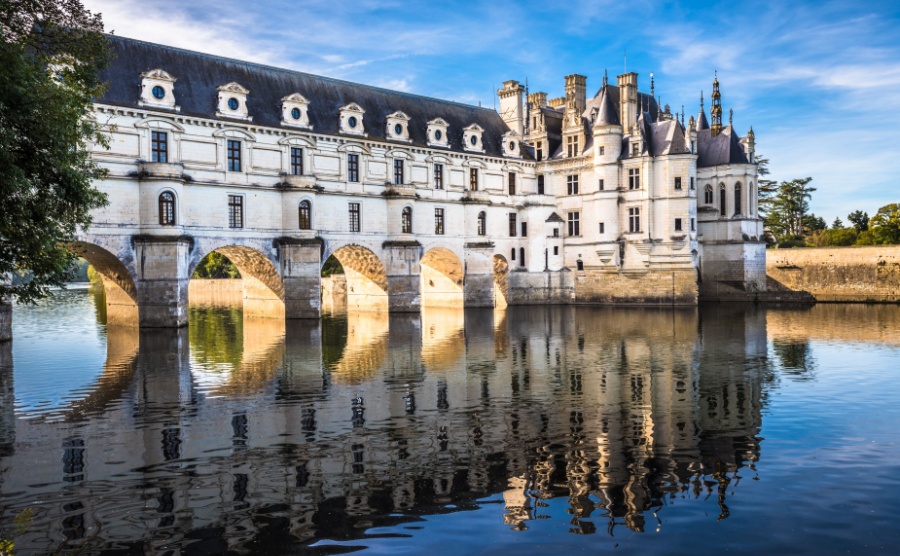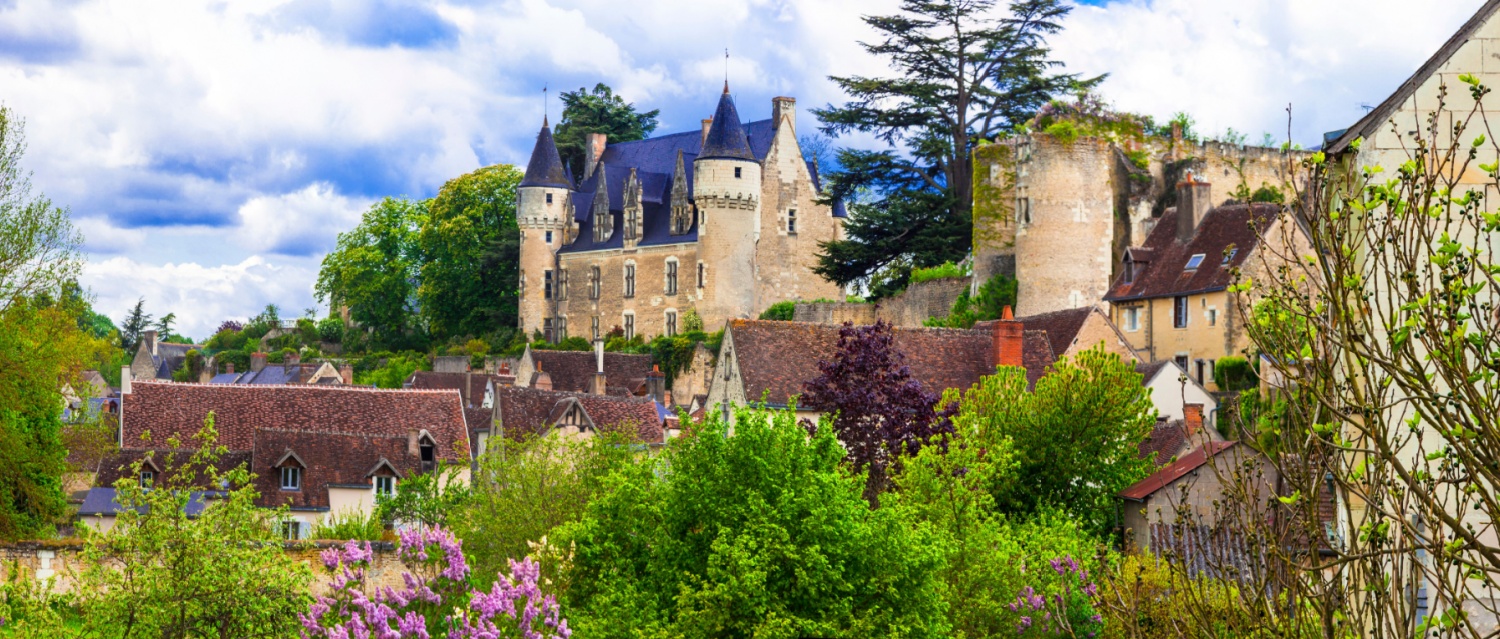In 2000, UNESCO inscribed the central Loire Valley – from Sully-sur-Loire in the east to Chalonnes-sur-Loire in the west – on its list of World Heritage Sites, describing it as “an exceptional cultural landscape” shaped over two millennia by human interaction with the environment. But this picture postcard setting is somewhere you can also make a home – and for less than Provence, the Côte d’Azur or parts of the Dordogne.
Just 90 minutes from Paris and well connected by road and air, the cities, towns and villages of the Loire Valley can be your gateway into the rest of Europe. Whether you are going home to visit family, having friends to stay or travelling for work, you won’t find yourself isolated.
Dotted with hundreds of chateaux and medieval villages and a handful of bustling cities, all linked by river and rolling countryside, you can choose between a rural and metropolitan home. The Loire Valley is often praised for its architectural heritage and natural beauty, but for overseas buyers, its real value lies in how it balances culture, space and quality of life.
If you’re thinking about buying a property in France, this region offers much more than first impressions suggest.

Chateau de Chenonceau is just one of the hundreds of chateaux in the Loire Valley
A region shaped by history and the river
The Loire Valley stretches for 280 kilometres along the middle course of the Loire River, crossing two administrative regions: Centre-Val de Loire and Pays de la Loire.
In Roman times, it was a key trading route. Then during the medieval period, it became a defensive frontier, marked by fortress towns like Chinon and Loches. But it was during the 15th and 16th centuries that the region came into its own, when the French court settled here and the nobility followed, commissioning châteaux of extraordinary scale and elegance. Their legacy remains in the landscape today: over three hundred castles, palaces and manor houses, many open to the public, others carefully preserved as private homes.
In the east, Orléans – one of France’s oldest cities – is closely associated with Joan of Arc and features a carefully restored old quarter, a Gothic cathedral and several museums. Travelling west, you’ll find Blois, whose hilltop château blends Gothic, Renaissance and Classical styles and served as the residence of several French kings. Nearby, Amboise overlooks the river from a dramatic promontory and was home to both King François I and Leonardo da Vinci, who spent his final years at the Château du Clos Lucé.

The old town of Amboise is known for its distinctive timbered houses
Further west, Tours serves as the region’s largest city and a centre for culture, education and gastronomy. Its well-preserved old town, timber-framed houses and vibrant markets make it particularly attractive to buyers looking for a lively yet manageable city. Not far from Tours, Villandry is famous for its landscaped Renaissance gardens, while Azay-le-Rideau appears to float above the river on its own reflection.
Saumur, with its turreted château, cavalry school and riverside setting, has long been a draw for those seeking a blend of elegance and tradition. It’s also in the heart of one of the Loire’s finest wine regions.
Beyond the larger towns, smaller villages offer their own unique histories and charms. Chinon is known for its medieval old town and connections to Henry II and Eleanor of Aquitaine. Candes-Saint-Martin, located at the confluence of the Loire and Vienne rivers, is often described as one of the most beautiful villages in France. So too is Montrésor, where Renaissance buildings, rock-carved homes and riverside walks create a setting of remarkable character and visual interest.

Angers is a vibrant city that wears its history on its sleeves
Living in the Loire
The Loire Valley presents a well-balanced alternative to more saturated property markets such as Provence or the Côte d’Azur. Here, daily life is shaped by strong local traditions, community events, and a thriving regional identity that is both historic and quietly contemporary.
Local markets remain central to life in the region’s towns and villages, offering seasonal produce, regional cheeses, and local wines. Weekly markets can be found in nearly every commune – from the bustling stalls of Tours and Angers to the smaller gatherings in villages such as Langeais or Candes-Saint-Martin.

Even in Autumn, you can cycle along the Loire river
The Loire is also one of the most cycle-friendly regions in France. The Loire à Vélo route stretches over 900km from Cuffy to Saint-Brevin-les-Pins, tracing the river through vineyards, forests and historic towns. The route is fully signposted and mostly flat, attracting both keen cyclists and casual riders. It connects with the larger EuroVelo 6 route, which links the Atlantic with the Black Sea.
Cultural life remains active year-round. In addition to major heritage attractions such as Château de Chambord and Chenonceau, the region supports a growing number of contemporary art venues.
The Château de Montsoreau – Musée d’Art Contemporain is a standout example. Housed in a 15th-century riverside château, the museum holds France’s largest collection of works by the conceptual art group Art & Language.

Day to day life in Tours sees you surrounded by medieval architecture
In Orléans, the Frac Centre-Val de Loire focuses on experimental architecture and contemporary visual art, while the CCCOD (Centre de Création Contemporaine Olivier Debré) in Tours hosts international exhibitions in a purpose-built space opened in 2017.
Community events are frequent and varied. Seasonal festivals celebrating wine, music, gardens and art punctuate the calendar. The Festival International des Jardins in Chaumont-sur-Loire, for example, draws landscape designers and visitors from around the world each summer with its themed outdoor installations. Smaller festivals like Les Heures Musicales de Cunault or Jazz à Montlouis maintain a strong local following and reinforce the valley’s reputation for cultural diversity.
The region’s climate is another advantage. The Loire Valley enjoys a temperate climate with relatively mild winters and warm – but not oppressive – summers. In Angers, for instance, average maximum temperatures reach 24.9°C in July and 24.7°C in August, while average winter lows remain above freezing.
This mesoclimate has long contributed to the valley’s reputation as the ‘Garden of France’. Vineyards produce some of the country’s most popular wines – from crisp Sancerre and Pouilly-Fumé in the east to Muscadet in the west – while fruit orchards and market gardens line the riverbanks.

You are just 90 minutes from Paris thanks to the TGV
Living in the Loire Valley offers a distinctive blend of cultural depth and everyday practicality. The pace may be slower than in France’s major cities, but it is not disconnected. Local infrastructure is strong, with TGV connections from Tours and Angers to Paris Montparnasse in just over an hour, and excellent regional healthcare and education facilities.
For buyers seeking a meaningful change in lifestyle—without cutting themselves off from modern amenities – the Loire offers a compelling choice.
What sort of property will you find?
The Loire Valley offers a wide range of property types, often at lower prices than more saturated regions such as Provence, the Côte d’Azur or parts of the Dordogne.
Whether you’re looking for a lock-up-and-leave bolthole, a family home, or a character-filled renovation project, the Loire is known for offering space, architectural charm and value.
Traditional village houses are widely available, particularly in the departments of Indre-et-Loire, Maine-et-Loire, and Loir-et-Cher. These properties often feature original tuffeau stone façades, wooden beams, slate roofs, and period details such as fireplaces and terracotta floors.

Life in the quiet village of Chedigny would let you live a slower life
Villages such as Chédigny, Crissay-sur-Manse, and Candes-Saint-Martin are particularly attractive to buyers seeking peaceful surroundings without sacrificing charm.
For those wanting more space, longères – traditional single-storey stone farmhouses – are available across the countryside, often with outbuildings and gardens. These make excellent family homes or holiday retreats and are especially common in the Loire-Anjou-Touraine Natural Regional Park.
In urban centres such as Tours, Angers, and Orléans, you’ll find a more contemporary housing stock, including apartments in well-maintained 19th-century buildings, modern townhouses, and new-build residences. These cities offer walkable neighbourhoods, strong public transport, and access to cultural life, making them attractive to working professionals, digital nomads and retirees seeking urban convenience with a gentler pace.

The Loire ties together many of the cities and towns in the region
The Loire Valley is also popular with buyers interested in renting. The region’s tourism economy is well established, creating strong potential for gîtes and chambre d’hôtes (B&Bs). Well-presented properties near the Loire à Vélo cycle route or in picturesque towns such as Azay-le-Rideau, Langeais, or Montrésor are especially in demand.
Overall, the region offers a rare combination of space, architectural interest and relative affordability. Whether you’re looking to restore a château, open a rural guesthouse, or simply enjoy village life in a stone-built cottage, the Loire’s property market offers variety and potential without the overheated competition of better-known regions.

Montrichard is just one of the cities digital nomads could call home
Who’s buying?
For many, the Loire Valley offers an alternative to the more crowded and costly property markets in the south of France.
While some buyers are looking for a permanent move – often in retirement – others are purchasing second homes for extended holidays or future relocation.
The appeal lies in the region’s space, heritage, and cultural life, combined with relatively affordable prices and lower levels of tourism outside the major châteaux.
The Loire’s balance of tranquillity and connectivity makes it particularly attractive to digital professionals. Cities such as Tours, Angers, and Orléans now benefit from improved broadband infrastructure and a rise in flexible co-working spaces. Tours, for example, has launched the “La Pépinière” innovation centre to support freelancers and tech workers.
Families are also making the move, attracted by lifestyle and education options. France’s state school system is well regarded, and the region is home to several bilingual and international programmes.

Perhaps the cobbled streets of Chinon is more to your taste?
Healthcare services in the Loire Valley rank among the best in France, with CHU Angers and CHRU Tours serving as major teaching hospitals with strong reputations in cardiology, oncology, and maternity care.
Accessibility is another key advantage. The TGV high-speed train connects Tours and Saint-Pierre-des-Corps to Paris Montparnasse in just over an hour, and Angers can be reached from Paris in under 90 minutes. This makes the region viable for those who still need to travel for work or maintain ties to the capital.
The A10 and A85 motorways provide convenient road access to Bordeaux, Nantes and Lyon, while regional airports at Tours Val de Loire and Angers Loire offer seasonal flights to destinations in the UK and other parts of Europe.
Crucially, the Loire Valley offers space without isolation. Buyers who are leaving larger cities – whether in France or abroad – will find they can settle into village life without losing access to everyday amenities. Mid-sized towns such as Loches, Saumur, and Blois offer post offices, pharmacies, banks, supermarkets, and weekly markets – alongside independent cafés, bookshops and galleries.
Whether you’re seeking a primary residence, a flexible second home or a place to build a business, the Loire attracts buyers looking for more than a postcard setting.
Planning your purchase
If you’re considering a property here, you’ll need to think through the usual practicalities: legal requirements, property taxes, and currency exchange. Working with local specialists – including a currency expert if you’re buying from outside the eurozone – can help you navigate the process with confidence.
But once you’re settled, the benefits are clear. This is a region where heritage, landscape and everyday life are all closely linked. Whether you’re after a permanent move or a part-time retreat, the Loire Valley is well worth serious consideration.
If you’re ready to explore what’s possible, speak to one of our property consultants today.





